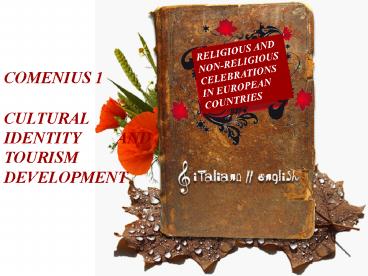Diapositiva 1 PowerPoint PPT Presentation
1 / 14
Title: Diapositiva 1
1
RELIGIOUS AND NON-RELIGIOUS CELEBRATIONS IN
EUROPEAN COUNTRIES
COMENIUS 1
CULTURAL IDENTITY AND TOURISM DEVELOPMENT
2
ITALY
Countrys religions
- Catholics 88
- Protestants 5
- Muslims 5
- Others 2
3
Religious National
ADVENT
4 weeks before Christmas
There are no special celebrations, but during the
last days of Advent pifferari, or bagpipe
players coming from Calabria, Molise, Abruzzo and
other regions play the bagpipes in the streets.
4
IMMACOLATA (Feast of the Immaculate Conception)
Religious National
December 7th 8th
The day before, December 7, is a day of fasting,
which ends in the evening with a dinner where
seven different courses are served . By the
IMMACOLATA the Christmas trees and Cribs are
ready.
5
NATALE (Christmas)
Religious National
December 24th-26th
People go to Mass, there are big lunches and
dinners, children open their presents. On 26th
bonfires are lit up in the streets to warm the
Holy Child. Usually on 25th, 26th, 1st Jan. and
6th Jan. some towns organize Living Cribs in
areas of natural or archaeological interest.
6
Religious National
EPIFANIA
(Epiphany)
January 6th
On the night of 5th children wait for an old
witch who comes flying on a broom and fills
stockings with presents.
7
CARNEVALE (Carnival)
Religious National
February
People wearing funny costumes sing, dance and
play tricks in the streets. Many italian cities,
Venice, Viareggio, Putignano, are famous for
their Carnival parades with big decorated
carriages. On Ash Wednesday La Quaremma (The
Lent) a puppet representing an old and ugly
woman, can be seen hanging, e.g., from some
windows to remind people to do penance.
8
Religious - Local
SAN GREGORIO
(St. Gregory the Great)
March 12th
This is Manduria Patron Saints feast, but
every Italian town celebrates its Patron Saint
with street band concerts, fun fairs, stalls
along the floodlit streets and fireworks.
9
Non Religious - Local
FIERA PESSIMA
(The Ugly Fair)
March 8th-12th
Our Fiera Pessima is an important trade fair
and takes its name from the bad weather
conditions that usually characterize the whole
week.
10
Religious National
PASQUA (Easter)
April
Statues representing the crucial moments of the
Passion are taken in procession along the city
streets on Good Friday. On Saturday evening,
people go to Mass, usually at midnight on Sunday
families enjoy big lunches and parents and
relatives give children chocolate eggs with a
surprise inside.
11
SAGRE ESTIVE
Non Religious -Regional
(Summer Festivals)
Summer is a great time for outdoor music and
performing arts festivals all over Italy. Food
festivals are held in small towns and villages.
They attract not only tourists, but also
families, teenagers, senior citizens, all
enjoying dinner together. Typical food and local
wine are free or reasonably priced. Music, games
and vendors selling toys, sweets and worthless
merchandise often accompany the festivals and
celebrations.
12
FESTA DELLASSUNTA
Religious -National
(Feast of the Assumption of the Blessed Virgin
Mary)
August 15th
Charming processions by boat are organized by all
sea towns.
13
Non Religious -Regional
LA NOTTE DELLA TARANTA (The Night of the
Tarantula festival)
August 25th
The festival aims at recovering the tradition of
pizzica salentina, a traditional Salentine
folk music, and combining it with other musical
styles. It takes place in the towns of Grecia
Salentina(Salentine Greece) in August and lasts
for about one month, the last and most important
day being the 25th, when the concert starts in
the evening and finishes at dawn.
14
Religious Non Religious /National
SAN MARTINO
(Saint Martins day)
November 11th
On the eve and on St.Martins day people taste
vino novello (new wine) and eat caldarroste
(roast chestnuts). November 9th, 10th, 11th are
called St. Martins Summer, because the sun
rays often warm up the air bearing witness to the
legend of the Saints cloak.

